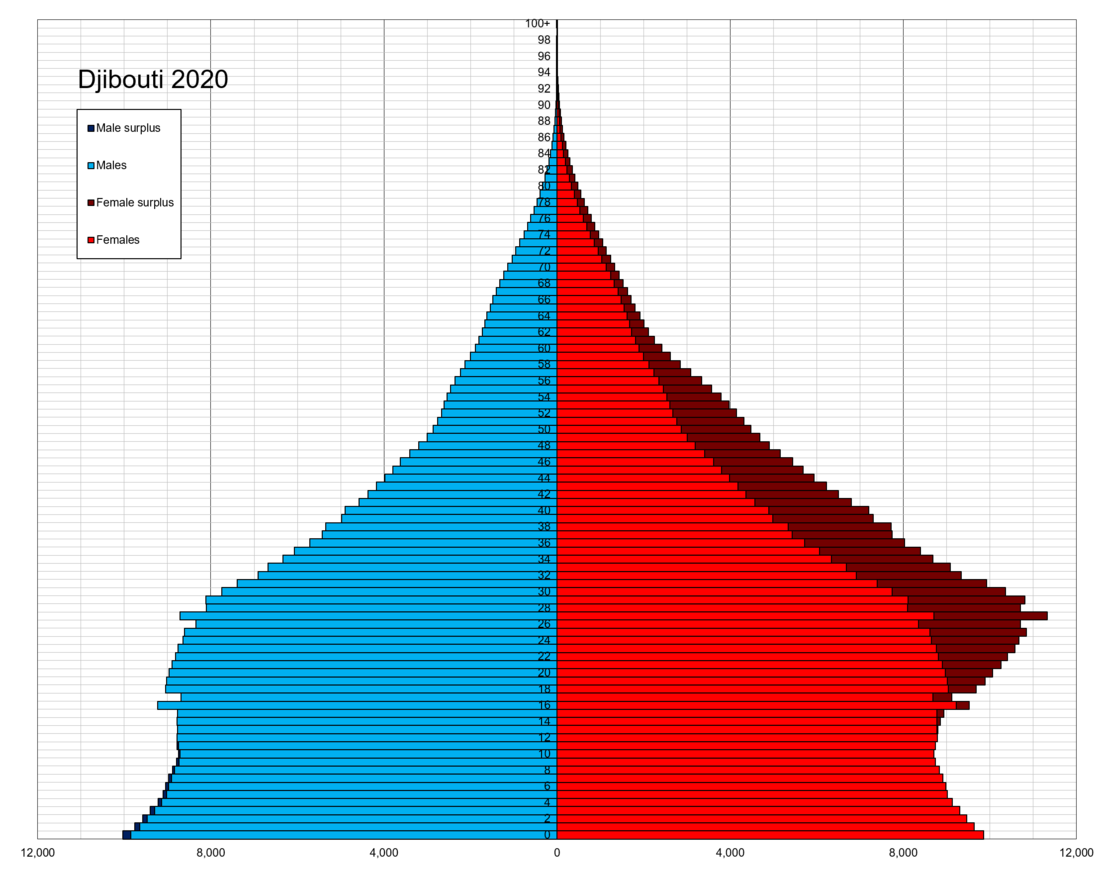Top Qs
Timeline
Chat
Perspective
Demographics of Djibouti
From Wikipedia, the free encyclopedia
Remove ads
Demographic features of Djibouti include population density, ethnicity, education level, health, economic status, religious affiliations and other aspects.
Remove ads
Population
Summarize
Perspective
Djibouti is a multiethnic country. As of 2024, it has a population of around 1,066, 809 inhabitants[2][3].[4] Djibouti's population grew rapidly during the latter half of the 20th century, increasing from about 69,589 in 1955 to around 869,099 by 2015.[5]
According to the 2022 revision of the World Population Prospects[2][3], the total population was 1,105,557 in 2021 compared to 62,000 in 1950. The proportion of children below the age of 15 in 2010 was 35.8%, 60.9% was between 15 and 65 years of age, while 3.3% was 65 years or older.[5]
Population by Sex and Age Group (Census 29.V.2009):[6]
Population Estimates by Sex and Age Group (01.VII.2021): [7]
Projections
The following are UN medium variant projections; numbers are in thousands:[5]
- 2025 1,166
- 2030 1,262
- 2035 1,356
- 2040 1,447
- 2045 1,535
- 2050 1,619
Remove ads
Vital statistics
Summarize
Perspective
Registration of vital events in Djibouti is incomplete. The Population Department of the United Nations prepared the following estimates.[5]
Life expectancy
Remove ads
Ethnic groups

The two largest ethnic groups native to Djibouti are the Somalis (61%) and the Afar (34%). The Somali clan component is mainly composed of the Issa. The remaining 5% of Djibouti's population primarily consists of Arabs,Ethiopians and Europeans (French and Italians).[9]
In addition, as of 2021, 4,000 American troops, 1,350 French troops, 600 Japanese troops, 400 Chinese troops, and an unknown number of German troops are stationed at various bases throughout Djibouti. Approximately 76% of local residents are urban dwellers; the remainder are pastoralists.[10][11][12][13]
Languages
Djibouti is a multilingual nation.[10] The majority of local residents speak Somali (850,000 speakers in Djibouti city, Dikhil and Ali Sabieh) and Afar (100,000 speakers)[14] as a first language. These languages are the mother tongues of the Somali and Afar ethnic groups, respectively. Both languages belong to the larger Afroasiatic family. There are 2 official languages in Djibouti: Arabic and French.[15]
Arabic is of religious importance. In formal settings, it consists of Modern Standard Arabic. Colloquially, about 59,000 local residents speak the Ta'izzi-Adeni Arabic dialect, also known as Djibouti Arabic. French serves as a statutory national language. It was inherited from the colonial period, and is the primary language of instruction. Around 17,000 Djiboutians speak it as a first language. Immigrant languages include Omani Arabic (38,900 speakers), Amharic (1,400 speakers), Greek (1,000 speakers) and Hindi (600 speakers).[15]
Remove ads
Religion
94% of Djiboutians are Sunni Muslim, the remaining 6% are mostly Christian, and there are a few mostly foreign-born residents who are Shia Muslim, Hindu, Jewish, Bahá'í, or atheist.[16]
References
External links
Wikiwand - on
Seamless Wikipedia browsing. On steroids.
Remove ads



